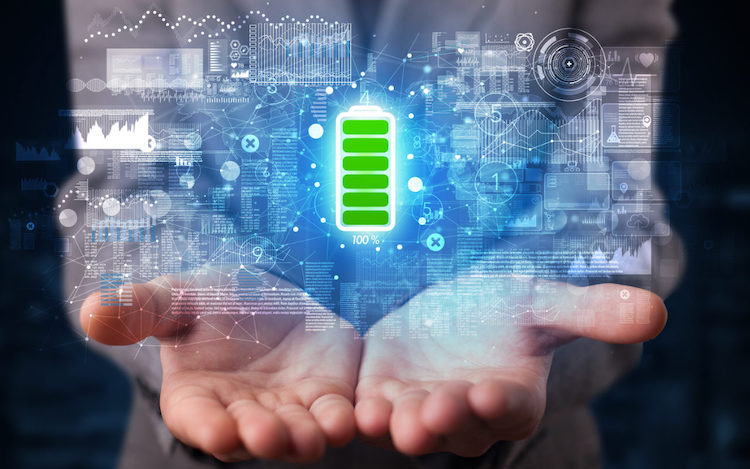Battery tech PR efforts continue to share the spotlight as emerging clean technologies dependent on energy storage can help transform and strengthen the clean energy transition. Most energy and finance experts alike point to energy storage, namely developments in battery chemistry, as the essential driving force to help reduce carbon emissions in transportation, utility transmission, residential real estate and more. Producing energy is easy, storing and optimizing it for use is the critical part of living in a greener world. Optimizing battery storage allows for lower energy costs, while reducing and eliminating the use of fossil fuels forever. For this reason, battery tech PR and news is more important and relevant than ever.
U.S. Battery Storage Had a Record Quarter. Here’s Why It Could Have—and Should Have—Been Much Better | Inside Climate News
“The United States added a record amount of energy storage in the second quarter. Energy storage developers completed 1,680 megawatts of projects in the second quarter, the highest ever for a single quarter, and an increase of 21 percent from the second quarter last year, according to a report issued this week..
Energy storage is a vital part of the transition to clean energy because it works well with intermittent resources like wind and solar power, storing electricity for use during times of high demand. To make a successful transition, the grid is going to need vast amounts of energy storage,
In the meantime, quarterly and annual records will continue to fall. The question going forward is whether the growth is enough to facilitate a rapid transition to clean energy.”
Exclusive: Tesla proposes building battery storage factory in India | Reuters
“Tesla (TSLA.O) has drawn up plans to make and sell battery storage systems in India and submitted a proposal to officials seeking incentives to build a factory, two people aware of the plan said, as Elon Musk continues a push to enter the country.
Tesla proposed supporting the country’s battery storage capabilities with its “Powerwall”, a system that can store power from solar panels or the grid for use at night or during outages, said the sources who declined to be named as the matter is confidential.
Indian officials have also conveyed that Tesla will have to work on reducing the cost of its battery storage products, the first source said, adding that the government could help to unlock the market with demand expected to be high.”
Tesla makes no shortage of battery tech PR efforts.
Energy Department investing $325M in batteries that can better store clean electricity | The Hill
“The Energy Department will invest $325 million in batteries that can better store clean energy, it announced Friday. The funding will go toward 15 projects in 17 states and one tribal nation that aim to “advance energy storage technologies” and accelerate the development of long-duration energy storage (LDES) technologies.
The department said the investment hopes to reduce impacts on the electric grid in cases of climate change-fueled extreme weather events and protect communities from blackouts.
Expanding cheaper, longer and more efficient LDES technology is needed to meet energy demand. The projects feature many LDES technologies, including a battery that provides up to 100 hours of power.”
“It’s Done.” The Future Is Battery-Powered Electric Cars | Bloomberg
“ All of the major automakers are taking the plunge on EVs, which is driving down prices and expanding available options. Globally, this year will see more than 14 million electric cars sold, according to BloombergNEF, compared with just 700,000 in 2016. And some 23 countries have now passed a crucial EV tipping point — 5% of new-car sales — after which adoption picks up dramatically.
Despite the tacit consensus on the future of drivetrains, obstacles remain for electric cars to meet their emissions-reduction potential. China’s dominance over the EV and battery supply chains has become a point of contention for other countries, as have China’s domestic subsidies for electric cars. In the long term, McKerracher says the growing competition will yield a race to the top in terms of quality and efficiency. In the short term, though, it may slow climate progress.
One of the ones that’s kind of underappreciated is that we’re just now at the stage where a lot of the large manufacturers have dedicated battery electric vehicle architectures, where they built their EVs from the ground up. Some of these latest vehicles coming out capable of a 350 kilowatt charge, some even higher, which means that you get into that sort of 15 minutes to get from 20% to 80% of the battery.”
The Electric: Fast-Charging Silicon Comes to EVs | The Information
“Engineers have improved lithium-ion batteries little by little since the debut of the first modern electric vehicles a decade and a half ago, making tweaks that together have tremendously reduced cell prices and boosted driving range. But a truly blockbuster breakthrough has evaded the industry, something that in a single stroke could make EVs go farther, cost less or both.
Now, though, an increasing number of automakers, including Mercedes, Porsche, Tesla and Lucid Motors, appear close to debuting EVs powered by next-generation batteries. These batteries will be costly at first. But they could later become that more widely available blockbuster advance.
The advance is in anodes with a high concentration of silicon, whose development as a battery material has been held up because it relentlessly expands and contracts during cycling, eventually killing the battery. Battery makers have figured out how to contain the swelling within hard shells around the anode and cavities inside it, and are now scaling up factories in Kansas, the state of Washington, South Korea and elsewhere.”
Installing solar isn’t the only big financial decision to make about controlling home power | CNBC
“After a summer of extreme weather and wildfires and now during the peak of hurricane season, the power going out again is becoming familiar to more Americans. That means it may be a good time to consider a home backup power storage system.
In coastal areas, for instance, considerations include the resilience of storm or sea walls, the quality and capacity of drainage infrastructure and the electrical grid’s hardiness, he said. In other areas, extreme weather conditions like high winds, tornados and ice may cause falling trees or downed lines — a risk that’s significantly mitigated if there are buried utility lines rather than overhead lines
Also consider the long-term savings potential with electrical upgrades, spent around $8,000 on a fossil fuel-powered whole home generator. Putting that money into solar instead might have been more economical because of the energy savings over time and tax incentives, he said.”
Innovation in battery tech PR have major financial implications.
The massive battery storage projects that will replace coal and gas, and fossil cars | RenewEconomy
“A leading energy consultant is predicting a 15-fold increase in the deployment of battery storage over the next decade and a half, as the world’s car fleets turn electric and as huge, multi-gigawatt hour battery storage projects replace coal and gas.
The forecast by Rethink Energy also suggest lithium iron phosphate batteries will come into their own during the late 2020s as stationary storage exclusively switches to this chemistry, and as key regions swap it in due to longer product lifespans and that anticipated drop in demand for very long-range batteries.”
In a US first, new EV battery cells will be made with recycled metals | Electrek
“Four companies will together produce new lithium-ion EV batteries that contain recycled metals in a US first. Global battery maker BASF, Florida-HQ’ed graphene energy storage maker Nanotech Energy, Reno-based lithium-ion battery recycling company American Battery Technology Company (ABTC), and Ontario-based TODA Advanced Materials that produces metal hydroxide materials for rechargeable battery makers will together work to create this domestic closed-loop system for lithium-ion EV battery cells.
Using recycled metals in new lithium-ion EV battery production can reduce the CO2 impact of batteries by about 25% compared to the use of primary metals from mines, according to BASF, which has been providing recycling services and cathode active material based on recycled metals in Asia for years. BASF also recently announced battery recycling capacity in Europe.”
Battery tech PR must emphasize what happens with batteries at the end of their life cycle.
EV battery material breakthrough could cut charging times to 6 minutes | FreeThink
“Road transportation — mainly, cars and trucks — is responsible for 12% of global greenhouse gas emissions, and almost a quarter of emissions in the US. Swapping out gas- and diesel-powered vehicles for electric ones could make a big difference in the battle against climate change.
Increasing the storage capacity of EV batteries would mean drivers wouldn’t have to worry about charging up as frequently, but we can’t just make batteries bigger — they’re already heavy, and even bigger ones could affect acceleration and handling.
Most lithium-ion batteries have anodes made of graphite covered in a copper foil, but researchers at the Pohang University of Science and Technology (POSTECH) say they’ve developed a way to get an alternative anode material, called “manganese ferrite,” to hold 1.5 times as many lithium ions as previously thought possible.
Ultimately, we will need high-capacity, fast-charging batteries in our EVs, and manganese ferrite could be the key to getting there — but the answer might also lie in batteries with silicon anodes, solid electrolytes, nickel cathodes, or something else entirely.”
Battery tech PR efforts are needed to distinguish the many differences in battery chemistry.
Will the U.S. EV battery recycling industry be ready for millions of end-of-life batteries? | International Council on Clean Transportation
“The Inflation Reduction Act, now past its first anniversary, gives consumers and automakers in the United States a strong incentive to buy or sell a new electric vehicle (EV): a federal tax credit of up to $7,500. But for vehicles to qualify for the full clean vehicle credit, both the minerals and the components used in lithium-ion EV batteries must meet new provisions aimed at strengthening the domestic supply chain.
Luckily, the domestic content requirements of the Clean Vehicle credit can be met in another way: procuring the minerals from recycling battery material. Right now, the EV battery recycling industry is in its infancy: in fact, most of the lithium-ion battery materials going into recycling plants today do not come from end-of-life EV batteries but rather from scrap material created during lithium-ion battery production. This makes sense, given that most EV batteries produced through 2023 are still on the road. But with the Inflation Reduction Act potentially adding 37 million EVs on the roads between 2023 and 2032, recycling end-of-life EV batteries will take on new urgency.
We will continue to monitor and analyze the development of EV battery recycling policies around the globe. Such policies will become increasingly critical—for the environment, human health, and EV supply chains—as tens of millions of batteries reach the ends of their lives.”
LG Energy To Invest $3 Billion To Supply Toyota with EV Batteries | Investopedia
“LG Energy Solution will supply lithium ion battery modules for Toyota Motor Corp. (TOYOF) beginning in 2025, the two companies announced. The 20GWh-capacity batteries will be made of high-nickel NCMA (nickel, cobalt, manganese, aluminum) pouch-type cells. To meet the terms of the agreement, LG Energy will invest roughly $3 billion in new production lines at its Michigan battery plant.
With our 30 years of experience in lithium-ion batteries, we will provide innovative power solutions to support Toyota’s push further into battery electric vehicles,” LG Energy CEO Youngsoo Kwon said in the statement. “The agreement also presents another big opportunity for us to strengthen our production capacity in North America.”
LG’s battery tech PR efforts consistently yield top tier coverage.
India’s Reliance unveils swappable, multipurpose batteries for EVs | Reuters
“Indian oil refining giant Reliance Industries showcased its swappable and multipurpose battery storage technology for electric vehicles (EVs) on Wednesday, as it makes a big push on clean energy. Reliance, led by billionaire Mukesh Ambani, displayed removable and swappable batteries for EVs that can also be used to power household appliances through an inverter at a renewable energy exhibition. The idea is that a person can use one battery for mobility as well as for powering appliances at home, company executives at the event said, requesting not to be quoted as they are not authorized to speak with media.
Clean auto technology is central to India’s strategy of cutting pollution in major cities and reaching its broader climate goals. Electric vehicles currently make up a fraction of total sales in India mainly due to their high price as the batteries are imported, and a lack of charging infrastructure.
The government is trying to encourage swappable batteries to bring down costs and promote wider adoption of EVs.”
NASA Battery Tech to Deliver for the Grid | IEEE Spectrum
“Heinemann is CEO of EnerVenue, a nickel-hydrogen battery manufacturer based in Fremont, Calif. “Our cost is comparable to where lithium-ion is going, and we use earth-abundant materials,” he says. “Nickel is the most expensive thing we use. We operate at a 90 percent round-trip efficiency, more efficient than lithium-ion. And there’s basically no maintenance on this battery, it was designed for sending up on a rocket ship into outer space.
Nickel-hydrogen batteries look and work unlike any other battery. They consist of a stack of electrodes inside a pressurized gas tank. The cathode is nickel hydroxide and the anode is hydrogen. When the battery is charging, a catalytic reaction generates hydrogen gas. During discharge, the hydrogen oxidizes and converts back to water.
Another advantage is that the battery chemistry works across a wide temperature range. That means any given battery-storage bank requires no costly heating, air-conditioning, ventilation, and fire-suppression systems—all of which require their own maintenance and upkeep, in addition to sapping a company’s bottom line.
So far, EnerVenue has been operating a pilot production line that can manufacture 100 megawatt-hours’ worth of batteries per year—and they’ve deployed small-scale test systems. But, says Heinemann, the company already has over 7 GWh, or about $400 million dollars’ worth of purchase orders, including from solar energy developer Pine Gate Renewables and Schlumberger New Energy. “Our mission,” he says, “Is to become the No. 1 provider of stationary storage serving power plants, businesses, and homes globally.”
***Guest post from FischTank PR interns: Veronica Riga and Bianca Roque ***
Looking for a cleantech PR firm to support your visibility and media presence about battery tech PR and more?
FischTank PR works with top brands and companies in the cleantech, climate, sustainability, and renewable development industries, helping them achieve various communications and public relations strategies designed to boost their business and promote the industry’s message. If you’re looking for a PR firm with great industry understanding and a results-oriented approach to media relations, please contact us at [email protected]




